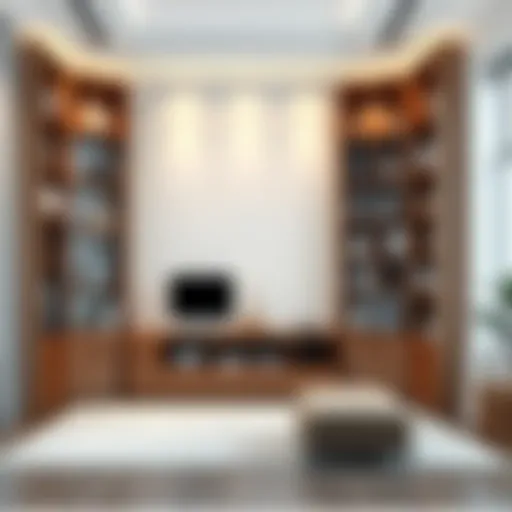The Beauty of Scandinavian Bathroom Tiles: A Guide
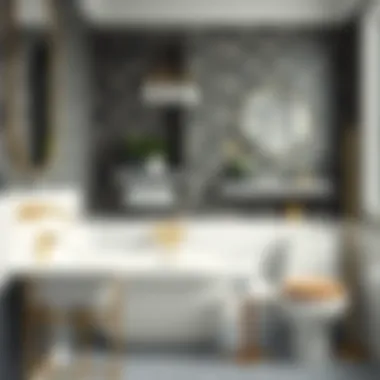

Intro
Scandinavian design has become synonymous with simplicity, functionality, and elegance. Among the various facets of this aesthetic, bathroom tiles hold a special place. They not only serve practical purposes but also act as a canvas for self-expression and style. Let's take a closer look at what makes Scandinavian bathroom tiles so distinctive, bridging the gap between functionality and beauty.
Every element in a Scandinavian bathroom setting is carefully curated to create harmony. The tiles used in these spaces embody a minimalist ethos, often using natural materials and muted color palettes. As we dive deeper into this exploration, we will uncover the essential characteristics and trends that set these tiles apart.
From defining color trends to understanding the interplay of materials, this guide aims to equip homeowners, designers, and decor enthusiasts with valuable insights. But before we move onto discussing specific trends and styles, let’s set the stage for the parts that make up this aesthetic—both traditional and modern.
Foreword to Scandinavian Design
Scandinavian design embodies a unique confluence of practicality and aesthetic minimalism, a combo that's become increasingly sought after in contemporary homes, particularly in bathroom spaces. The hallmark of this style is its unwavering commitment to functionality paired with uncluttered beauty. When we dive into Scandinavian bathroom tiles, understanding the broader spectrum of Scandinavian design is paramount. This context not only grounds the discussion about tile characteristics but also illustrates their intended purpose within a bathroom setup.
Historical Context
The journey of Scandinavian design can be traced back to the early 20th century, notably flourishing post-World War II. A reaction to the chaos of war and economic upheaval, it sought to promote well-being through simplicity and efficiency. The ethos was about making beautiful designs accessible, veering away from the ornate and often impractical aesthetics popular in other cultures.
Scandinavian countries—namely Denmark, Norway, and Sweden—rooted their design philosophy in nature’s beauty. The climates there also played a key role; long winters meant that the need for warmth, comfort, and light became essential considerations. As manufacturers began to develop products, they prioritized sustainability and functionality, using locally sourced materials and championing craftsmanship.
Core Principles of Scandinavian Aesthetics
Scandinavian design is guided by several core principles that resonate deeply in the realm of bathroom tiles. Among them:
- Minimalism: Emphasizing simplicity, it rejects excess, focusing on what is necessary.
- Functionality: Every element serves a purpose, from the layout to the materials used.
- Natural materials: There’s a strong preference for natural components like wood, stone, and clay which bring earthy tones into the interiors.
This simple yet profound approach invites the homeowner to cultivate a sense of connection with their surroundings. In scenic Swedish towns or the Danish coastlines, the beauty of nature is reflected in the clean, linear designs that drive Scandinavian interiors. That connection isn't just aesthetic; it's functional, making every day a little easier and more enjoyable—for instance, waterproof tiles that don’t just look good but are also incredibly durable against the wears of daily life.
Defining Characteristics of Scandinavian Bathroom Tiles
Understanding the distinct features of Scandinavian bathroom tiles is crucial not only for aesthetic appeal but also for functionality and long-term satisfaction in bathroom design. The tile's material, color, and design choices all contribute to creating a soothing and balanced environment, reflective of the Scandinavian design philosophy. Each characteristic plays a vital role and when selected thoughtfully, can bring about a harmonious and practical bathroom space.
Material Choices
Porcelain
Porcelain tiles are celebrated for their versatility and durability. These tiles are crafted from refined clay and fired at high temperatures, giving them a dense and water-resistant quality. This makes porcelain an ideal option for bathrooms, where moisture levels can be a concern.
One key characteristic of porcelain tiles is their ability to mimic the look of natural stones or wood, offering a beautiful aesthetic without the necessary maintenance. Homeowners often appreciate this characteristic as it combines luxury with practicality. However, it's essential to understand that while porcelain is robust, its installation can require expert handling due to its density. Improper installation may result in cracking, so seeking professional help is recommended for a flawless finish.
Ceramic
Ceramic tiles, being one of the most common choices for bathroom surfaces, offer a broad palette of colors and patterns. The composition is similar to porcelain but not as dense, which can translate to lower costs. A notable aspect of ceramic tiles is their ease of installation and variety of design options, making them a go-to for many renovation enthusiasts.
While ceramic is generally easier on the budget, it’s worth mentioning that their resilience is slightly less than that of porcelain. They can handle day-to-day wear well, but in areas where high moisture is present, they may not perform as effectively as porcelain. Thus, one should weigh costs against expected durability in the bathroom setting.
Natural Stone
Natural stone tiles such as travertine or slate bring a unique charm that synthetic options can seldom replicate. Each tile comes with its distinct variations, allowing homeowners to curate a truly one-of-a-kind bathroom aesthetic. Natural stone tends to retain heat well, providing comfort underfoot.
However, the maintenance challenge arises with natural stone due to its porous nature. Sealants are often necessary to prevent water damage and stains. Therefore, while they afford a sophisticated look, one needs to commit to regular upkeep to keep them looking their best, balancing beauty with effort.
Color Palettes
Earthy Tones
Earthy tones are foundational in Scandinavian design. These colors, reminiscent of nature, evoke a sense of calm and grounding that can transform a bathroom into a serene retreat. Utilizing colors like soft browns, muted greens, or warm greys allows for a connectedness to the outdoors, a hallmark of Scandinavian aesthetics.
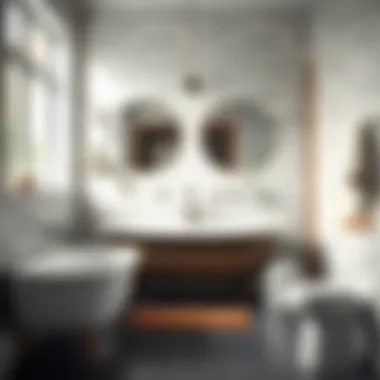

The beauty of earthy tones lies in their versatility. They pair exceptionally well with various materials, easing the integration of tiles with wooden fixtures or natural stone elements. Nevertheless, it’s essential to carefully select shades to ensure the space feels cohesive, as mixing too many hues can lead to a chaotic appearance.
Soft Neutrals
Soft neutral colors are about creating lightness in the bathroom, enhancing the feeling of space and tranquility. Shades such as off-white or light beige can help reflect light, making even the smallest bathrooms appear larger. This color choice also acts as a perfect backdrop for incorporating other design elements.
Another attractive quality of soft neutrals is their compatibility with various accents. Accessories like towels or artwork in brighter colors can easily stand out against a neutral backdrop. However, it's important to note that using too many soft neutrals without any contrasting elements can give a washed-out look, thus finding the right balance is key.
Bold Accents
In contrast to the serene palette of earthy tones and soft neutrals, bold accents in tile design offer personality and flair. Exotic blues or deep greens can serve as striking focal points, adding depth and richness to a bathroom. This approach can be particularly effective in smaller areas where bright tiles create an illusion of space and movement.
With bold accents, homeowners should carefully consider placement. Utilizing them in moderation, like as a border or in specific sections, can have striking visual effects without overwhelming the design. Nonetheless, one should be cautious; if overused, bold colors might overshadow the relaxing essence typically associated with Scandinavian bathrooms.
Patterns and Textures
Geometric Designs
Geometric patterns are not only visually appealing but also work well in fostering a sense of structure within the bathroom layout. They can bring a contemporary twist to the Scandinavian style, infusing life and interest into the space. Tiles with geometric designs add rhythm and can guide the eye throughout a room, enhancing the overall flow.
However, it’s worth mentioning that selecting geometric patterns requires a sharp eye for balance. Too many competing patterns can lead to disarray, while a well-placed geometric design adds a dynamic touch without veering into chaos.
Subtle Textures
Subtle textures on tiles can add dimension while adhering to the minimalist Scandinavian ethos. Textured tiles bring warmth and tactile elements, enticing the senses without disrupting the overall simplicity of design. A lightly textured surface can soften the starkness often associated with modern designs, producing a gentle contrast against smoother elements.
Even so, when opting for textured tiles, careful consideration must be taken when cleaning. Textured surfaces may require more effort to maintain their appearance compared to flat tiles, making them a choice that balances elegance with practicality.
Matte Finishes
Matte finishes offer understated elegance in Scandinavian bathrooms. They reduce glare and add a soft, luxurious feel to the tiles. This finish creates a cozy atmosphere, which aligns perfectly with the idea of a calming bathroom retreat. Matte tiles are also less slippery than shiny varieties, enhancing safety in wet areas.
However, matte finishes can be more susceptible to showing stains or marks. Homeowners must be prepared for regular cleaning to keep these tiles looking pristine. This draws attention to the practical consideration of tile upkeep that comes along with aesthetic choices.
Durable, beautiful, and harmoniously designed, Scandinavian bathroom tiles offer a unique blend of form and function, catering to modern needs without losing touch with minimalism and nature.
Functionality and Practicality
When it comes to Scandinavian bathroom tiles, the ideals of functionality and practicality are at the crux of their design philosophy. Emphasizing minimalism doesn’t merely stop at aesthetics; it extends into the usability and longevity of the materials. Homeowners, designers, and DIYers must appreciate that the right tile choices not only enhance the visual appeal of a bathroom but also stand the test of time while being easy to maintain.
The importance of functionality in Scandinavian design cannot be overstated. It’s about creating a space that is both beautiful and long-lasting. Thus, tiles must endure moisture, foot traffic, and frequent cleaning. By selecting durable materials that are specifically designed for wet environments, one can ensure a harmonious blend of beauty and reliability.
Durability and Maintenance
Durability plays a pivotal role when considering bathroom tiles. Materials like porcelain and natural stone are commonly favored due to their robust characteristics. Porcelain tiles, for instance, are renowned for their high density and resistance to moisture and staining. This means they won’t easily chip or crack, making them ideal for high-use areas like bathrooms. Here are a few considerations to keep in mind:
- Long Lifespan: Quality tiles can last for decades, which is a significant benefit for homeowners looking at long-term investments.
- Ease of Cleaning: Glazed surfaces, common in many Scandinavian tile designs, require minimal effort to clean. A simple damp cloth often suffices to maintain their beauty.
- Resistant to Fading: The colors retain their vibrancy even in humid conditions, which is an essential trait in wet environments.
"Choosing durable bathroom tiles reflects a home’s enduring character and commitment to quality over time."
Water Resistance
In addition to durability, water resistance is paramount for bathroom tiles. Scandinavian designs often favor tiles that are not just aesthetically pleasing but also designed to combat the common threat of water exposure. Essentially, the right materials can act as a barrier against mold and mildew, ensuring a hygienic space.
- Porcelain and Ceramic Tiles: These materials typically feature a water absorption rate of less than 0.5%, which makes them ideal for bathrooms. They don’t swell or warp, providing peace of mind during heavy use.
- Natural Stone: While beautiful, some natural stones require more care and treatment to maintain their water-resistant properties. It’s essential to apply proper sealing to prevent moisture penetration.
- Grout Selection: Not all grouts are created equal. Opting for epoxy grout can offer a more watertight seal compared to traditional cement-based options. This not only enhances durability but also adds to the overall water resistance of your tiled surfaces.
Ensuring that bathroom tiles are both durable and water-resistant will culminate in a space that not only looks great but also functions well, keeping in line with Scandinavian design principles of simplicity and practicality.
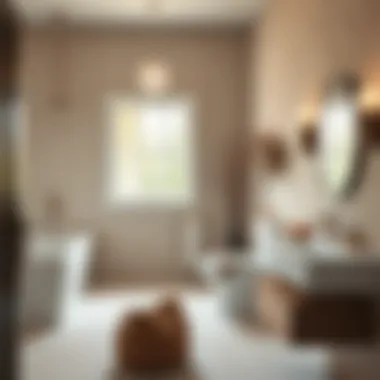

Designing a Scandinavian-Inspired Bathroom
Creating a Scandinavian-inspired bathroom implies more than just picking a few tiles and calling it a day. It’s about weaving together elements of simplicity, functionality, and subtle beauty. Scandinavian design is deeply rooted in a philosophy that values nature, minimalism, and a connection to the surroundings. A bathroom designed with this aesthetic not only serves its primary function but does so without unnecessary fuss or clutter.
When homeowners embark on this journey, they need to consider how each aspect—from the tiles they choose to the fixtures and layout—contributes to that wholesome feel that characterizes Scandinavian interiors. There’s a genuine art to making a bathroom that balances utility with an attractive, comforting environment. Balancing light, colors, and materials can change the whole vibe, making the space feel larger and more inviting.
Adding elements like generous natural light and airy designs can also create a fresh atmosphere. Understanding how tiles integrate with other components lays the groundwork for a design that doesn�’t just look good, it feels good.
Integrating Tiles with Other Elements
Fixtures
Fixtures in a Scandinavian bathroom often embody simplicity while functioning reliably. Think about sleek sink designs or thoughtfully integrated faucets. A popular choice among designers is polished chrome or brushed finish metals that enhance the clean lines typical of Scandinavian decor. It’s not just about appearance; these fixtures often offer better usability and durability, making them a practical choice. Their resistence to wear and tear aligns seamlessly with the Scandinavian ethos of functionality—every piece has to serve a purpose.
A unique feature to keep in mind is how the color and finish of fixtures can complement tile choices. For instance, stainless steel may elegantly contrast matte black tiles, creating a visually appealing blend of textures.
Fittings
Fittings are equally significant, ensuring that every detail maintains the minimalist aesthetic while providing necessary functionality. Popular fittings might include those with clean geometric shapes, which pair well with tile designs echoing natural forms or soft lines. By selecting fittings with smooth surfaces and understated designs, homeowners can uphold the serene atmosphere characteristic of Scandinavian bathrooms.
Moreover, certain fittings may offer eco-friendly options; low-flow taps conserve water while still performing effectively. The downside might be that some eco-friendly options can sometimes come at a higher initial cost, but they may save money over time on water bills and maintenance.
Storage Solutions
The importance of storage in a bathroom cannot be overstated, particularly within a Scandinavian context where clutter detracts from the overall feeling of calm. Smart storage solutions, like floating shelves or built-in cabinets, can maintain that minimalist vibe. These solutions emphasize functionality without sacrificing style, as they can beautifully showcase decorative items or necessary products without overwhelming the senses.
An added advantage of efficient storage is that it facilitates easy organization and access, making daily routines smoother. A common downside, however, is that it requires thoughtful planning to ensure everything fits well within the space without feeling cramped.
Creating a Cohesive Look
Color Harmony
Color harmony in a Scandinavian bathroom is critical—it's what ties individual elements together into a cohesive whole. Soft whites, grays, and muted earth tones form the backbone of this palette, evoking calm and tranquility. By adhering to a limited color palette, homeowners can create a visual flow that feels natural and inviting.
This design choice reflects the Scandinavian love for nature; it's about bringing the outdoors in, and that’s achieved by letting the color choices resonate with the hues found in a Nordic landscape. The unique feature of using color harmony is its ability to make a space feel larger and more connected to the outdoors, while also potentially making it easier to coordinate with various accessories or fixtures.
Spatial Arrangement
Finally, the spatial arrangement is key in realizing a Scandinavian-inspired bathroom. Consider how elements interact with each other—how a well-placed basin can manage traffic flow while keeping the space feeling open. Appropriate spacing encourages movement and ensures that while everything looks good together, it also remains functional.
Highlighting natural light and optimizing the layout can work wonders. A well-thought-out arrangement can dramatically enhance both usability and comfort. However, this requires careful planning, as poor spatial decisions can lead to a cramped and uncomfortable atmosphere, which is completely contrary to the intended design philosophy.
"In Scandinavian design, every piece is chosen with intention, creating spaces that breathe and flow."
Cultural Significance of Tile Use
Tiles in Scandinavian bathrooms hold more than just a decorative purpose; they are a tangible connection to both the past and the present, woven deeply into the fabric of cultural identity. The right tile can shift a space from mere utility to a robust reflection of personal and communal values. With an emphasis on quality, sustainability, and minimalism, Scandinavian design principles prioritize functionality while enhancing aesthetic appeal. This exploration of cultural significance digs into how tradition intersects with modernity and how these tiles are influencing broader global design movements.
Tradition and Modernity
Scandinavian tile usage harks back to craftsmanship rooted in the region’s history. Historically, tiles adorned humble abodes and monumental structures alike. From medieval churches to family farms, their enduring presence illustrates a constant that has remained amid change. The unique artistry displayed in historical tiles is often grounded in nature, embodying motifs inspired by the surrounding landscapes and seasons. This deep appreciation for nature continues in modern installation practices that embrace organic materials and environmentally friendly production techniques.
Consider how the transition from traditional glaze techniques to contemporary matte finishes speaks volumes about this balance. While bright glazes epitomized the exuberance of a bygone era, today’s understated matte tiles invite a calming ease. Homeowners might opt for earthy tones that echo Scandinavian woodlands or the soft snowy palate of winter, bridging century-old aesthetics with current trends. This blending of old and new creates a dynamic wherein tiles not only serve aesthetic purposes but also act as narratives of progress—each installation expressing an understanding of heritage while contributing to a modern lifestyle.
Influence on Global Design Trends
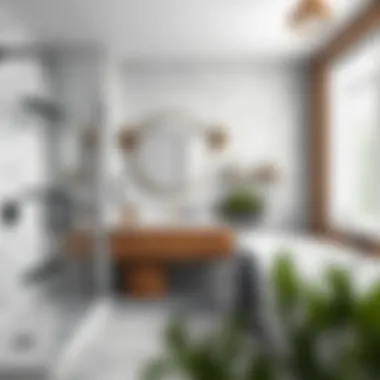

Over the years, the clean lines and functional beauty of Scandinavian tiles have set the stage for numerous global design trends. Architects and designers worldwide are taking cues from the simplicity and authenticity found in these tiles. When we look at open-plan living spaces or chic minimalistic cafés, we can often trace their design sensibilities back to Scandinavian influences. The way tiles are arranged and selected becomes a universal language of style that communicates clarity and precision.
Key trends influenced by Scandinavian tile use include:
- Emphasis on functionality: Tiles are designed not only for beauty but also for ease of use and maintenance, resonating deeply with minimalist philosophies.
- Eco-conscious products: As sustainability becomes a focal point in design, Scandinavian tiles made of recycled materials or sourced from responsibly managed quarries are in high demand.
- Integration into broader design concepts: Today’s bathrooms often integrate these tiles into larger themes, such as biophilic design, where natural textures and colors create an oasis-like feeling.
A significant takeaway from such trends is the realization that bathroom tiles, while simple in concept, can embrace and disseminate vast cultural narratives. They not only encapsulate the essence of Scandinavian style but also inspire contemporary worldwide design norms, making them a vital component in places that seek to harmonize beauty and practicality.
Sustainable Choices in Tile Selection
In recent years, the spotlight on sustainability has shifted from a niche consideration to a mainstay in all aspects of home design, and Scandinavian bathroom tiles are no exception. The emphasis here is not just on aesthetics but also on how certain choices can contribute to a healthier planet. Understanding the importance of sustainable practices not only aligns with eco-conscious values but also enhances the overall quality of the living space.
Homeowners and designers alike are increasingly recognizing that making mindful selections can yield multiple benefits, from reducing ecological footprints to increasing the longevity of their installations. The focus here will be on two critical components: eco-friendly materials and energy efficiency in production, each playing an integral role in crafting a sustainable bathroom sanctuary.
Eco-Friendly Materials
Building our discussion on eco-friendly materials, let’s take a closer look at the nuances that make these choices particularly relevant.
Recycled Content
One of the most impactful aspects of tile sustainability is the utilization of recycled content. This involves repurposing materials that might otherwise end up in landfills. The key characteristic of recycled content is its ability to reduce the demand for virgin materials, subsequently minimizing the energy and resources needed for production.
The standout benefit of tiles made from recycled content lies in their contribution to waste reduction. For instance, by sourcing tiles that incorporate post-consumer glass or reclaimed clay, each installation can become a statement piece that tells a story about sustainability.
However, it's essential to note that while these tiles can be visually appealing and environmentally friendly, their unique feature often includes variations in texture and shade, which might not resonate with every homeowner's vision. Despite this, their advantages in promoting a circular economy far outweigh the drawbacks of occasional inconsistency.
Sourcing Practices
The sourcing practices behind tile production are equally vital in the sustainable equation. Responsible sourcing often focuses on materials that are derived from local or sustainably managed suppliers. This aspect promises to decrease the overall carbon footprint associated with transportation and extraction.
A significant key characteristic of sound sourcing practices is the support of local economies, which can foster a sense of community and connection in design. Companies that ensure ethical environmental practices highlight their commitment not just to sustainability but also to consumer welfare, making them a preferred choice for many.
A unique feature is the transparency within the supply chain, which can manifest as traceable sourcing documentation. Consumers may occasionally find it tricky to navigate the labyrinth of sourcing claims, yet such transparency is crucial in ensuring that ethical practices are genuinely in place.
Energy Efficiency in Production
The final pillar supporting sustainable choices in tile selection is energy efficiency in production. This entails reducing the energy consumption associated with the manufacturing process, which often has a significant environmental impact.
Manufacturers that prioritize energy-efficient production not only lessen their ecological harm but often pass these savings onto consumers. Efficient production serves to minimize wastage and can lead to lower costs in energy usage over the lifespan of the products. Moreover, many manufacturers are investing in renewable energy sources for their facilities, further contributing to sustainability.
The End: The Future of Scandinavian Bathroom Tiles
As we draw to a close on our exploration of Scandinavian bathroom tiles, it's essential to reflect on what makes this topic not just relevant today but also crucial for the future of design in home spaces. The evolving nature of materials and aesthetic preferences signals a shift in how bathroom spaces are conceived and designed, adapted seamlessly to modern living.
Evolving Trends
The trends in Scandinavian bathroom design are continuously evolving, influenced by innovations in materials and shifts in consumer preferences. One significant trend is the emphasis on sustainability. Homeowners are more conscientious about their choices, opting for eco-friendly materials that minimize environmental impact. This includes tiles that are not only durable but also sourced responsibly, reflecting a broader awareness of ecological responsibilities.
Moreover, technology is playing its part too; smart tiles that can regulate temperature or even change color with mood lighting are beginning to pop up. These advancements align well with Scandinavian design principles, marrying functionality and aesthetics effortlessly.
Key trends to keep an eye on:
- Natural Aesthetics: A return to nature with organic shapes and materials.
- Minimalist Sophistication: Designs that embrace simplicity but are brimming with character.
- Integration of Technology: Incorporating tech features without compromising the clean lines and functionality.
"The best designs are those that marry beauty with function, ensuring that every element serves a purpose."
Enduring Appeal
The appeal of Scandinavian bathroom tiles lies in their understated elegance and versatility. They cater to a broad audience—from homeowners seeking serenity in their bathrooms to designers looking for that functional yet chic touch in projects. The use of soft hues paired with natural materials creates a calming retreat, a sanctuary that many long for in today's fast-paced world.
Beyond aesthetics, the practical benefits of these tiles ensure their place in future designs. They are often durable, easy to maintain, and resistant to moisture—qualities that meet the practical needs of any modern bathroom. This combination of beauty and functionality ensures that Scandinavian bathroom tiles will retain their allure, regardless of changing trends.
In summary, the future for Scandinavian tiles in bathroom design looks particularly bright. As designs evolve, these tiles will likely remain at the forefront, continuing to inspire and adapt—inviting homeowners and designers alike to create spaces that balance beauty, simplicity, and sustainability.













